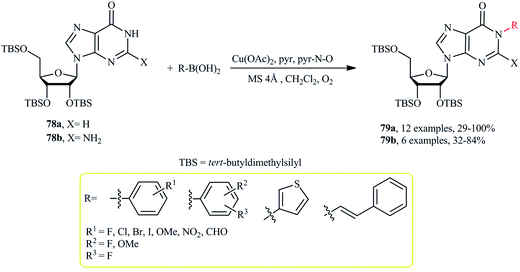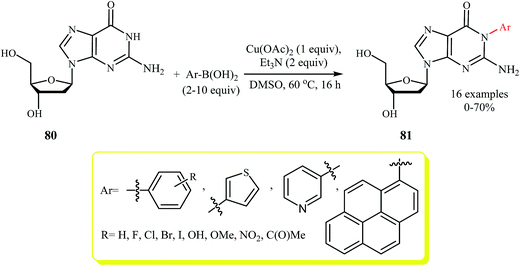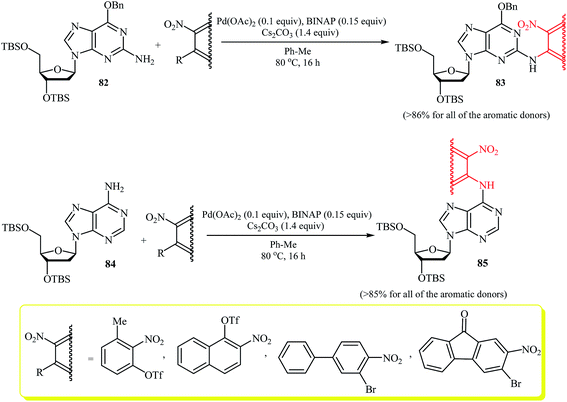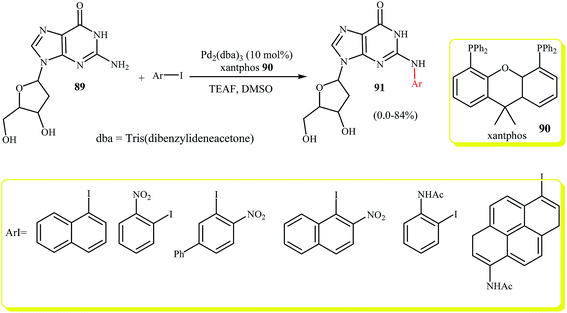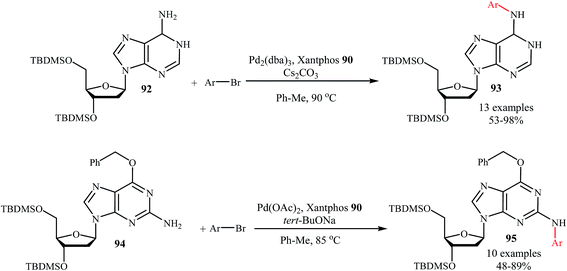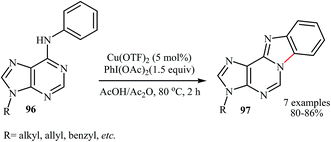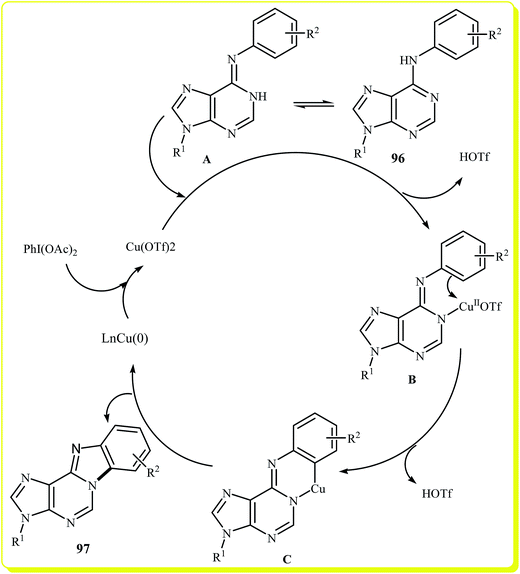New developments in direct functionalization of C–H and N–H bonds of purine bases via metal catalyzed cross-coupling reactions
Morteza Abdoli
a,
Zohreh Mirjafary
*b,
Hamid Saeidian
c and
Ali Kakanejadifard
*a
aDepartment of Chemistry, Lorestan University, Khorramabad, Iran
bDepartment of Chemistry, Tehran Science and Research Branch, Islamic Azad University, Tehran, Iran. E-mail: zmirjafary@srbiau.ac.ir
cDepartment of Science, Payame Noor University (PNU), PO Box: 19395-4697, Tehran, Iran
First published on 8th May 2015
Abstract
Purine bases have attracted much attention due to their potential biological activities. Developing more efficient methods for the modification of purine bases with a substitution such as aryl or alkyl is particularly interesting. This review gives an overview of new developments in direct functionalization of C–H and N–H bonds of purine bases via metal catalyzed cross-coupling reactions in recent years.
1. Introduction
The fused imidazo [4,5-d]pyrimidine was named purine by Emil Fisher in 1884 who later achieved its synthesis in 1898. He showed that various substances, such as adenine, xanthine, caffeine, uric acid, and guanine all belonged to one homogeneous family and corresponded to different hydroxyl and amino derivatives of the same fundamental system.1 Purines constitute a major class of naturally occurring compounds (Fig. 1) and privileged medicinal scaffolds (Fig. 2) that exhibit a broad range of biological and pharmaceutical properties, such as antimicrobial,2 antibacterial,3 antiviral,4 antileishmanial,5 antifungal,6 antitumor,7 anticonvulsant,8 antidepressant,9 anti-inflammatory,10 antiparkinson11 and antidiabetic12 activities. In this regard, developing more efficient methods for the construction of compounds containing purine is a topic of immense importance.Three strategies have been utilized for the synthesis of functionalized purines in literature (Scheme 1): heterocyclization13 (method A) which the scope of it has been limited due to the harsh conditions, poor substituent tolerance, low chemical yields, and multistep synthesis. Metal-catalyzed cross-coupling reactions14 (method B) is a powerful and flexible protocol for the synthesis of functionalized purines which is well highlighted in literature in recent years.15 Direct metal-catalyzed C–H bond functionalization (method C) has emerged over the past 25 years as a powerful tool for the synthesis of organic molecules and pharmaceutical scaffolds that may complement or even replace traditional catalytic cross-coupling reactions. In these methods the inactive C–H bonds can be treated as a functional group, similar to the traditionally used C–(pseudo)halide bonds.16 This synthetic methodology offers several advantages:
(1) High atom economy.
(2) High functional group tolerance.
(3) Ease of handling.
(4) Shorter synthetic routes.
(5) Environmentally friendly processes (Green Chemistry).
To the best of our knowledge, a comprehensive review has not appeared on direct functionalization of C–H and N–H bonds of purines via transition-metal-catalyzed cross-coupling reactions in literature in recent years. In this review, we have classified these reactions based on the type (e.g. arylation, alkylation, alkenylation) and the position of functionalization. The most detailed discussion will be focused on the C8-arylation of titled compounds. There are few protocols for functionalization of C2–H and C6–H bonds via direct metal catalyzed processes, and inevitably we have only discussed C8-functionalization of the titled compounds. In the final section of this review, the new and regioselective methodologies for functionalization of N–H bonds of purines will be discussed. The main methods for direct functionalization of purines via metal catalyzed cross-coupling reactions are summarized in Fig. 3.
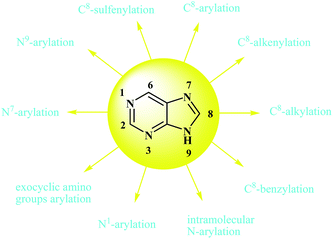 | ||
| Fig. 3 The main methods for direct functionalization of purines via metal catalyzed cross-coupling reactions. | ||
2. Direct C8–H arylation
2.1. Intermolecular Pd-catalyzed direct C8–H arylation
Almost all known direct C8–H arylations of purines proceeded by using palladium as a catalyst. The first example has been accomplished for synthesis of phenyl purine via direct C8–H activation employing Pd(OAc)2/PPh3 combination as catalytic system (Scheme 2).17 Hocek and co-workers described C8–H arylation of purines 3 using aryl iodides as an arylation agent in the presence of CuI and Cs2CO3 to form 4 (Scheme 3).18,19 It is noted that aryl chlorides under similar conditions did not follow through C–H activation reactions.However, in 2007 Chiong and Daugulis, attempted a similar conversion involving aryl chlorides instead of aryl iodides.20 The authors extended their methodology to the first successful direct C8–H arylation of caffeine with aryl chlorides in N-methyl-2-pyrrolidone involved treating Pd(OAc)2/BuAd2P as catalytic system with K3PO4 as base.
Free-(NH2) adenines 5 were found to undergo efficient C8–H arylation with various aryl halides in the presence of Pearlman's catalyst (Pd(OH)2/C) (Scheme 4). The reaction was more efficient using microwave irradiation. This system shows relatively good reactivity for a range of aryl halides. Under these conditions the yields of C8–H arylation using aryl chlorides were equally effective with as iodo and bromo reagents.21 Para electron-rich aryl halides and 1-halonaphthalene worked well under these reaction conditions. Meta- and para electron-deficient aryl halides gave the coupling products in moderate to good yields. However, ortho-substituted and sterically hindered aryl halides were relatively incompatible in this system.
With the objective of designing a comprehensive protocol to direct C8-arylation of purines, the scope of electrophilic partners were extended to aromatic sulfinic acid sodium salt.22 So several palladium sources, oxidants, additives and solvents were tested, and the system Pd(PhCN)2Cl2/Cu(OAc)2/dioxane/DMSO (9![[thin space (1/6-em)]](https://www.rsc.org/images/entities/char_2009.gif) :
:![[thin space (1/6-em)]](https://www.rsc.org/images/entities/char_2009.gif) 1) was found to be superior. It is worth noting that the electronic character of the substituents in sulfinic acid had remarkably little effect on the facility of reaction. Various substrates were examined involving electron donating and withdrawing groups in the para, ortho, and meta positions according to Scheme 5.
1) was found to be superior. It is worth noting that the electronic character of the substituents in sulfinic acid had remarkably little effect on the facility of reaction. Various substrates were examined involving electron donating and withdrawing groups in the para, ortho, and meta positions according to Scheme 5.
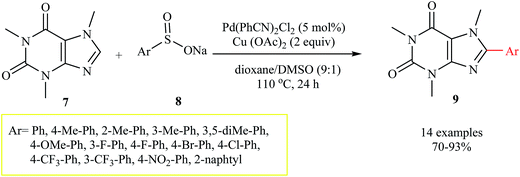 | ||
| Scheme 5 Using aromatic sulfinic acid sodium salts as an electrophilic partners in direct C8–H arylation of caffeine 7. | ||
An interesting palladium-catalyzed selective dehydrogenative cross-coupling of purines with various heterocycles such as thiophenes and furans was reported by You et al.23 The Pd(OAc)2/Cu(OAc)2·H2O/pyridine/1,4-dioxane system was found to be optimal for this reaction, while addition of 10 mol% CuCl as an activator gave excellent results. In 2011, this methodology was extended to regioselective C3-heteroarylation of indoles (Scheme 6) and pyrroles (Scheme 7) with an array of purines.24
The direct C–H arylation of purine nucleosides was reported by Hocek's research team in 2007.25 Adenosines 16 and 6-(4-methoxyphenyl)purine ribonucleoside 17 (Fig. 4) were observed to undergo C8–H arylation in the presence of alkyl halides with catalytic amounts of Cu(OAc)2 and CuI.
In an effort towards the development of an effective methodology for regioselective C8-arylation of adenine, Fairlamb's group employed Pd(OAc)2/CuI/Cs2CO3/DMF combination as a relatively efficient system for regioselective C8-arylation of unprotected adenine nucleoside using aryl iodides (Scheme 8).26 High yield was obtained with iodonapthalene under these conditions, and para electron-deficient aryl iodides gave the coupling products in moderate yields. A plausible catalytic cycle for the direct arylation of adenosine mediated by Pd/Cu in the presence of Cs2CO3 is outlined in Fig. 5. CuI metalation of acidic C8–H bond of adenosine followed by deprotonation at C8, leads to in situ generation of an organocuprate, which participates in metal exchange with Pd(II) intermediate in the catalytic cycle.
To develop a practical method for the synthesis of C8-arylated purine nucleosides, Fairlamb showed Pd(OAc)2/CuI is an effective catalytic system for direct C8-arylation of unprotected 2′-deoxyguanosine with aryl iodides at 80 °C (Scheme 9).27 DMF and Cs2CO3 were the best solvent and base, respectively, and addition of secondary amines was found to be necessary for efficiency of the reaction.
2.2. Intramolecular Pd-catalyzed direct C8–H arylation
In 2009, Barbero and co-workers reported an example of intramolecular C–H arylations of purines. They showed that 9H-purine 20 underwent intramolecular direct C8–H arylation in the presence of CuI as catalyst, LiOtBu as base in o-xylene at 150 °C. The corresponding fused purine 21 was obtained in yield of 58% (Scheme 10).28Comprehensive synthesis of fused purines 22 and 23 (Fig. 6) via intramolecular direct arylation were reported by Hocek's group.29 They examined three approaches relying on palladium catalyzed C–H arylation for synthesis of purino[8,9-f]phenanthridines 22 (Scheme 11).
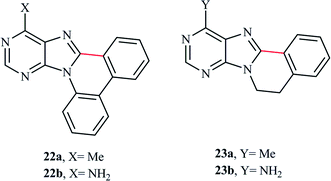 | ||
| Fig. 6 Chemical structure of purino[8,9-f]phenanthridines 22 and 5,6-dihydropurino[8,9-a]isoquinolines 23. | ||
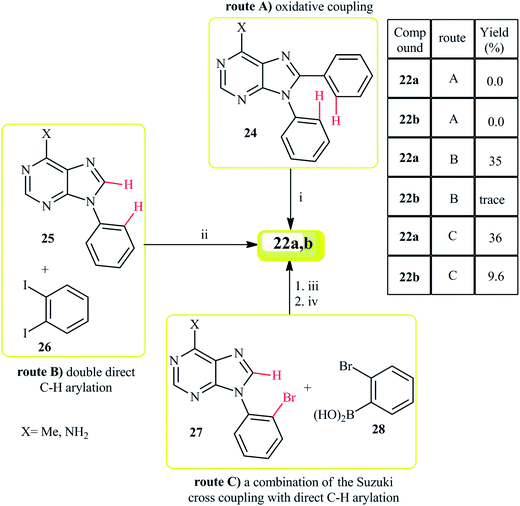 | ||
| Scheme 11 Retrosynthetic analysis of construction of the purino[8,9-f]phenanthridine core. (i) Several procedures.30–34 (ii) Pd(OAc)2 (10 mol%), P(Cy)3·HBF4 (20 mol%), TBAB (1 equiv.), KOAc (4 equiv.), 140 °C, 25 h. (iii) Pd(PPh3)4 (4 mol%), Na2CO3 (4 equiv.), aliquat 100 (8 mol%), toluene/H2O (2:1), 110 °C, 36 h. (iv) Pd(OAc)2 (5 mol%), P(Cy)3·HBF4 (10 mol%), K2CO3 (2.5 equiv.), DMF, 150 °C, 20 h (30 h for 1b). | ||
8,9-Diphenylpurines 24 underwent no reaction under oxidative coupling conditions.30–34 Moreover, double C–H arylation of 9-phenylpurines 25 with 1,2-diiodobenzene 26 gave moderate yields of the desired products (∼35%). The best result was obtained with consecutive Suzuki cross-coupling of 9-(2-bromophenyl)purines 27 with 2-bromophenylboronic acid 28 followed by intramolecular direct C–H arylation using Pd(OAc)2/PCy3-HBF4 as catalytic system at 130 °C for 8–16 h. Analogously, 5,6-dihydropurino[8,9-a]isoquinolines 23 were prepared via direct intramolecular C8–H arylation of 30. Intermediates 30 were generated by alkylation of purines 29 with 2-chlorophenethyl bromide in the presence of K2CO3 with reasonable yields (Scheme 12).
2.3. Intermolecular Ni and Cu-catalyzed direct C8–H arylation
In 2011, Qu and co-workers developed a novel protocol for nickel-catalyzed direct C8-arylation of purines with Grignard reagent at room temperature (Scheme 13).35 They tested several catalysts and oxidants, and the system Ni(dppp)Cl2/1,2-dichloroethane was found to be superior. Under optimized conditions, the reaction tolerates electron-donating substituents at meta and para positions of aryl moiety and gave corresponding coupling products in good to high yields, but extension of the reaction to electron-withdrawing and ortho-substituents aryl rings was failed. However, this methodology for synthesis of C8-arylated purines was problematic due to the requirement of a very high catalyst loading (30 mol%). | ||
| Scheme 13 Direct C–H arylation of 9-benzyl-6-methoxy-9H-purine 31 with various aryl Grignard reagents. | ||
A plausible mechanism for Ni-catalyzed C8–H arylation of purine 31 with Grignard reagents 32 in 1,2-dichloroethane is presented in Fig. 7. Reaction of Ni(dppp)Cl2 with 1,2-dichloroethane afforded NiCl2 which used for metalation of purine to give intermediate B. Transmetallation between 32 and B followed by reductive elimination provided the desired products.
Hong et al. described the use of CuI as a catalyst for selective dehydrogenative cross-coupling reactions of a range of azoles with quinolones36 in the presence of LiOtBu in 1,4-dioxane at 110 °C, and only one C8-heteroarylated purine was obtained in a yield of 79%.
2.4. Direct C8-alkenylation
Alami and co-workers recently reported one of the first palladium catalyzed direct C8-alkenylation of caffeine 7 with alkenyl halides. The reaction was undertaken at 130 °C using Pd(acac)2/CuI/P(o-tolyl)3 as catalytic system and t-BuOLi as base in THF.37 This method afforded the C8-alkenylated caffeine 36 in moderate to good yields with various mono-, di- and tri-substituted alkenyl halides 35 (Scheme 14).One year later, Piguel and co-workers investigated the effect of reaction parameters, such as different palladium catalyst, additives, solvents, and electronic effects of the coupling partners on the efficiency of the coupling reactions.38 Considering the catalyst, ligand, base and temperature, the optimized conditions of the reaction involved using Pd(OAc)2/CuI paired with phenantroline as a catalytic system, t-BuOLi as the base at 120 °C in dioxane under microwave irradiation for 30 min (Scheme 15). Although their optimized conditions allowed the reaction to be carried out at a relatively low temperature and short time comparing with those reported by Alami, an increased catalyst loading of up to 5 mol% was essentially required for effective coupling. It should be mentioned that in the only same example, Alami's method (A) gave higher yield than Piguel's method (B) (Scheme 16). Oxidation of sulfur atom of 39 with m-CPBA in dichloromethane afforded the corresponding sulfone, which underwent facile SNAr displacement with amines.
 | ||
| Scheme 16 Comparing the efficiency of Alami's and Piguel's methods for direct C8-alkenylations of caffeine. | ||
Interestingly, a recent work by You and co-workers disclosed that inactivated alkenes were also efficient coupling partners for direct alkenylation of purines.39 They established the dehydrogenative Heck coupling of N-heteroarenes involving purines 41 with alkenes 42 in the presence of Pd(OAc)2/CuCl/Cu(OAc)2·H2O afforded the corresponding π-extended alkenylated products 43 in good to high yields (Scheme 17).
2.5. Direct alkylation and benzylation
A preliminary example of intermolecular direct alkylation of purine with inactive alkenes has been reported by Bergman et al., requiring elevated temperature (150 °C), 5 mol% of [RhCl(coe)2]2 as a catalyst in the presence of LiCl. The low yields of C6/C8 alkylated byproduct (17%) were also observed (Scheme 18).40 Following this work, the same group in 2004, has investigated the alkylation of caffeine with 4-methylpent-1-ene under the aforementioned rhodium catalyst, but the low yield of desired product was observed (15%).41Seven years later, a more robust and versatile method for benzylation of xanthines was contributed by Alami's team. They have exemplified the benzylation of C-8 position of xanthine with a variety of benzyl chlorides in the presence of a combination of 2.5 mol% of [PdCl2(CH3CN)2] and 5 mol% of P(o-tolyl)3 as catalytic system (Scheme 19).42 Generally, both electron-donating and electron-withdrawing groups in the phenyl ring periphery of either coupling partner were well tolerated. In addition, ortho-substituted as well as bicyclic derivatives were also viable substrates. However, 3-fluorobenzyl chloride was failed to react under reaction condition and the starting material was recovered unchanged. Notably, the reaction conditions were compatible with functional groups such as halogens, esters, and sulfanes which are useful for further synthetic transformations.
A fascinating opportunity for synthesis of C8-alkylated purines with relatively good yields has been observed by using different primary and secondary Grignard reagents as an efficient coupling reagent using 20 mol% of Ni(dppp)Cl2 at room temperature (Table 1).43 Possible mechanism for formation of C8-alkylated purines with Grignard reagents is the same as shown in Fig. 7.
| Entry | R1 | R2 | Alkyl | Product | Yield (%) |
|---|---|---|---|---|---|
| 1 | OMe | Bn | Cyclopentyl | 50a | 81 |
| 2 | OMe | Me | Cyclopentyl | 50b | 87 |
| 3 | OMe | Et | Cyclopentyl | 50c | 91 |
| 4 | OMe | Cyclo-pentyl | Cyclopentyl | 50d | 75 |
| 5 | Cl | Bn | Cyclopentyl | 50e | 77 |
| 6 | 4-Ethyl-phenyl | Bn | Cyclopentyl | 50f | 89 |
| 7 | OMe | Bn | Pentyl | 50g | 76 |
| 8 | OMe | Bn | Cyclopropyl | 50h | 72 |
| 9 | OMe | Bn | Cyclohexyl | 50i | 94 |
| 10 | 4-Ethyl-phenyl | Bn | Ethyl | 50j | 53 |
2.6. Direct C8–H sulfenylation
Hocek and co-workers recently applied aryldisulfidesin as the coupling reagent in direct oxidative C–S bond formation at the C8-position of purines, providing a novel entry to arylsulfanyl derivatives of purine (Scheme 20).44 Purine 51 underwent sulfenylation with 1,2-diphenyldisulfane 52a and 1,2-bis(4-methoxyphenyl)disulfane 52b in the presence of t-BuOLi which gave corresponding C8-arylsulfenylation purines 53a–b in 60% and 56% yield, respectively. While the reaction with electron-poor 1,2-bis(4-nitrophenyl)disulfane 52c did not work. It should be mentioned that, the resulting 8-arylsulfanylpurines 53 undergo Liebeskind–Srogl coupling45 with arylstannanes or boronic acids in moderate to high yields (Scheme 21). To the best of our awareness, this is the only example of direct C8–H sulfenylation of purines reported so far.3. Functionalization of N–H bonds
3.1. N9–H arylation
There are two general routes for generation of N9-arylpurines 57 (Scheme 22). Traditionally, N9-arylpurines are prepared from the reaction of arylamine with chloropyrimidine 56 followed by ring closing (method A).46 An efficient and new method for the one-step synthesis of N9-arylpurines involves N9-arylation of purine via a C–N cross-coupling reaction (method B). The method A was not an efficient access because many tedious steps are required.47–49N9-arylation of purines has been reported by Lam and Chan, by using arylboronic acids as electrophilic partners.50 The use of Cu(OAc)2/N(C2H5)3 or Cu(OAc)2/pyridine system was found to be optimal for the Lam–Chan reaction conditions.51–54 This method is compatible with a very large range of meta- and para-substituted arylboronic acids, but it could not be extended to ortho-substituted arylboronic acids.52 It should be mentioned that during N9-arylation of purines with the Lam and Chan's method, low yields (10%<) of N7-regioisomer 59′ were also observed (Scheme 23).55
A completely regioselective N9-arylation of purines 60 has been developed in the presence of Cu(OAc)2, molecular sieves and phenanthroline (Table 2).48 It is noteworthy that this method doesn't work well for adenine, due to its low solubility.
Adenine can be efficiently arylated at the N9 position with arylboronic acids at room temperature in a CH3OH–H2O (4![[thin space (1/6-em)]](https://www.rsc.org/images/entities/char_2009.gif) :
:![[thin space (1/6-em)]](https://www.rsc.org/images/entities/char_2009.gif) 1) mixture as solvent.49 This method is compatible with a very large range of substrates, and gave corresponding coupling products in moderate to high yields.
1) mixture as solvent.49 This method is compatible with a very large range of substrates, and gave corresponding coupling products in moderate to high yields.
A versatile process for N9-arylation of amino-protected adenine 63 with arylboronic acids was described by Gothelf et al.56 They showed that the bis-Boc-adenine can be efficiently reacted with electron-rich, electron-poor and sterically hindered arylboronic acids at room temperature (Scheme 24).
The reported methods for N9-arylation of purines with arylboronic acids are associated with some drawbacks such as: (1) tedious separation of products from the arylboronic acid anhydrides, (2) low reaction yields with electron-deficient arylboronic acids and (3) in the most cases, long reaction time is required.
In 2011, Guo and co-workers reported an efficient and elegant protocol for regioselective N9-arylation of purines by using diaryliodonium salts 65 in the presence of CuBr/K2CO3/CH2Cl2 system.47 This method has several advantages such as good to excellent yields and broad substrate scope. It is worth to note that due to the poor solubility, (3-NO2C6H4)2I+Br− underwent no reaction (Table 2, entry 5), and (3-NO2-6-MeC6H3)2I+Br− gave a low yield (20%) (Table 3, entry 6).
Recently, a new and beautiful method was reported for selective aromatic N-arylation of amino-containing purines with aryl halides in water.57 The CuBr/DPPhen 67/KOH combination was found to be optimal for this reaction. Theophylline and adenine underwent coupling reaction with iodo- and bromobenzene in moderate to good yields (Scheme 25).
3.2. N7–H arylation
Dvořák and co-workers utilized the copper(II) catalyzed a cross-coupling reaction for the synthesis of N7-arylated guanine 72 and adenine derivatives.58 The amino-protected guanine 70 was found to undergo N7/N9 arylation with moderate to high selectivity (2![[thin space (1/6-em)]](https://www.rsc.org/images/entities/char_2009.gif) :
:![[thin space (1/6-em)]](https://www.rsc.org/images/entities/char_2009.gif) 1 to 6
1 to 6![[thin space (1/6-em)]](https://www.rsc.org/images/entities/char_2009.gif) :
:![[thin space (1/6-em)]](https://www.rsc.org/images/entities/char_2009.gif) 1) by using Cu(OAc)2/CH3OH/TMEDA system. The regioselectivity for this coupling reaction was highly affected by substitution on arylboronic acids (Table 4).
1) by using Cu(OAc)2/CH3OH/TMEDA system. The regioselectivity for this coupling reaction was highly affected by substitution on arylboronic acids (Table 4).
A reported route for the synthesis of N7-arylated guanines 77 involves the copper-mediated arylation of 7-methylpyrimido[1,2-a]purin-10(3H)-one 74 with arylboronic acids 71 by using Cu(OAc)2/TMEDA system followed by hydrolysis of generated 1-aryl-7-methylpyrimido[1,2-a]purin-10(3H)-ones 75 (Scheme 26).58
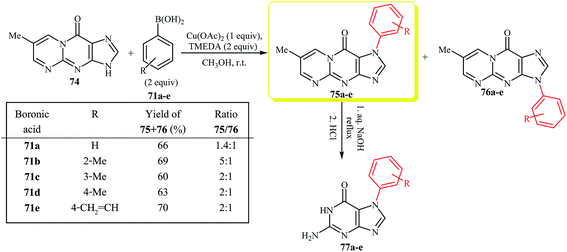 | ||
| Scheme 26 Cu-mediated synthesis of N7-arylated guanines 77a–e from 7-methylpyrimido[1,2-a]purin-10(3H)-one 74. | ||
3.3. N1–H arylation
Arterburn and co-workers investigated N1-arylation of inosine 78a and guanosin 78b with arylboronic acids in 2005 (Scheme 27).59 Both electron-donating and electron-withdrawing substituents at the meta- and para-position of arylboronic acids underwent the coupling in moderate to excellent yields, but it could not be extended to ortho-substituted aryl moiety. The presence of pyridine-N-oxide (pyr-N-O) as a co-oxidant or oxygen is vital for this reaction. In the absence of co-oxidant or oxygen, low reaction yields and long reaction time were observed.A method for the synthesis of N1-arylated 2′-deoxyribonucleosides 81 have been reported by Harvey et al. (Scheme 28).60 Copper(II)-catalyzed cross-coupling reaction of unprotected 2′-deoxyribonucleoside 80 with arylboronic acids in DMSO, affording N1-arylated 2′-deoxyribonucleosides in a vast range of yields (in the presence and the absence of ligand 0–92% and <10–95%, respectively).
3.4. Exocyclic amino group arylation
Protected derivative of 2′-deoxyguanosine (dG) 82 or 2′-deoxyadenosine (dA) 84 underwent Buchwald–Hartwing reaction in excellent yields with ortho-nitro aryl bromide or triflate, in the presence of catalytic amounts of palladium(II) acetate and racemic 2,2′-bis(diphenylphosphino)-1,1′-binaphthyl (BINAP) (Scheme 29).61The selective N-arylation of aminopurines with arylboronic acids has been developed in 2004.62 Treatment of the N9-benzyl-protected 6-chloro guanine 86 with arylboronic acids in the presence of Cu(OAc)2/NEt3/DMAP system was shown to be an effective reaction for exocyclic amino group arylation of purines (Scheme 30).
2′-Deoxyadenosine 16a was found to undergo efficient N6-arylation via copper-catalyzed direct coupling reaction with aryl halides as shown in Scheme 31. It is interesting to note that the electronic character of the substituents in the aryl halides had little effect on the facility of reaction. Moreover aryl chlorides failed to enter into the coupling reaction but aryl bromides reacted smoothly to give the desired products with reasonable yields. The reaction rate of the aryl bromides was increased by addition of sodium iodide.63
 | ||
| Scheme 31 Selective coupling reaction at exocyclic amino group of 2′-deoxyadenosine 16a with aryl halides. | ||
A different method for exocyclic N-arylation of aminopurines has been developed by using aryl iodide reagents in the presence of Pd2(dba)3 and xantphos 90. This study was mainly focused on arylation of 2′-deoxyguanosine 89 with ortho-iodonitrobenzenes (Scheme 32), some cases of other aryl donors such as 3-iodopyren and purines was also disclosed.64
A very similar approach for arylation of the exocyclic amino group of nucleosides 92 and 94 was reported by Ngassa and co-workers (Scheme 33).65 Pd2(dba)3/xantphos/Cs2CO3/PhCH3 system was found to be optimal for arylation of 2′-deoxyadenosine analogue 92. The optimized conditions for 2′-deoxyguanosine analogue 94 is Pd(OAc)2/xantphos/tert-BuONa/PhCH3. The reactions work well with electron-rich, electron-poor, naphthalene systems, and sterically hindered aryl bromides. The authors demonstrated that Pd catalyst with xanthos 90 as the supporting ligand is superior to BINAP-based ones.
3.5. Intramolecular N-arylation
The 6-anilinopurine derivatives 96 was found to undergo efficient direct C–H activation/intramolecular amination by using Cu(OTf)2 (5 mol%) and PhI(OAc)2 as oxidant (1.5 equiv.) in a mixture of AcOH/Ac2O as shown in Scheme 34. Depending on the electronic and steric effects of substituents on the aniline ring, substrates with electron-withdrawing groups gave higher yields than those with electron-donating groups, and para-substituted aniline ring were more reactive than ortho-substituted. A plausible catalytic cycle is depicted in Fig. 8.66 Combination of Cu(OTf)2 with purines 96, followed by an electrophilic substitution reaction resulted metallated purines B. Reductive elimination afforded the desired products 97.4. Summary and outlook
In conclusion, this review provides concise overview on the cross-coupling reactions on direct functionalization of purine bases. In these transformations the inactive C–H bonds can be treated as a functional group, similar to the traditionally used C–(pseudo)halide bonds. This research area has still further possibilities for growth and we believed that the highly versatile and extremely effective and novel procedures for the synthesis of functionalized purine bases will be attainable in the near future.Acknowledgements
We would like to thank Professor M. Farnia for providing helpful feedback that improved the manuscript.References
- M. Legraverend and D. S. Grierson, Bioorg. Med. Chem., 2006, 14, 3987–4006 CrossRef CAS PubMed.
- (a) F. A. Ashour, S. M. Rida, S. A. El-Hawash, M. M. El-Semary and M. H. Badr, Med. Chem. Res., 2012, 21, 1107–1119 CrossRef CAS; (b) P. R. Patel, C. Ramalingan and Y.-T. Park, Bioorg. Med. Chem. Lett., 2007, 17, 6610–6614 CrossRef CAS PubMed; (c) S. Amer, N. El-Wakiel and H. El-Ghamry, J. Mol. Struct., 2013, 1049, 326–335 CrossRef CAS PubMed; (d) M. Tunçbilek, Z. Ateş-Alagöz, N. Altanlar, A. Karayel and S. Özbey, Bioorg. Med. Chem., 2009, 17, 1693–1700 CrossRef PubMed; (e) H. Roggen, C. Charnock, R. Burman, J. Felth, R. Larsson, L. Bohlin and L. L. Gundersen, Arch. Pharm. Chem. Life Sci., 2011, 344, 50–55 CrossRef CAS PubMed.
- (a) G. Andresen, L. L. Gundersen, J. Nissen-Meyer, F. Rise and B. Spilsberg, Bioorg. Med. Chem. Lett., 2002, 12, 567–569 CrossRef CAS; (b) M. Gordaliza, Mar. Drugs, 2009, 7, 833–849 CrossRef CAS PubMed.
- (a) D. Kang, Z. Fang, B. Huang, L. Zhang, H. Liu, C. Pannecouque, L. Naesens, E. De Clercq, P. Zhan and X. Liu, Chem. Biol. Drug Des., 2015 DOI:10.1111/cbdd.12520; (b) K. Sekiya, H. Takashima, N. Ueda, N. Kamiya, S. Yuasa, Y. Fujimura and M. Ubasawa, J. Med. Chem., 2002, 45, 3138–3142 CrossRef CAS PubMed; (c) M. Hocek, P. Šilhár, I.-h. Shih, E. Mabery and R. Mackman, Bioorg. Med. Chem. Lett., 2006, 16, 5290–5293 CrossRef CAS PubMed; (d) J. R. Rao, R. F. Schinazi and C. K. Chu, Bioorg. Med. Chem., 2007, 15, 839–846 CrossRef CAS PubMed; (e) J. L. Clark, J. C. Mason, L. Hollecker, L. J. Stuyver, P. M. Tharnish, T. R. McBrayer, M. J. Otto, P. A. Furman, R. F. Schinazi and K. A. Watanabe, Bioorg. Med. Chem. Lett., 2006, 16, 1712–1715 CrossRef CAS PubMed; (f) Z. Yan, E. R. Kern, E. Gullen, Y. C. Cheng, J. C. Drach and J. Zemlicka, J. Med. Chem., 2005, 48, 91–99 CrossRef CAS PubMed; (g) N. Valiaeva, J. R. Beadle, K. A. Aldern, J. Trahan and K. Y. Hostetler, Antiviral Res., 2006, 72, 10–19 CrossRef CAS PubMed.
- (a) C. Peyron, R. Benhida, C. Bories and P. M. Loiseau, Bioorg. Chem., 2005, 33, 439–447 CrossRef CAS PubMed; (b) F. G. Braga, E. S. Coimbra, M. de Oliveira Matos, A. M. L. Carmo, M. D. Cancio and A. D. da Silva, Eur. J. Med. Chem., 2007, 42, 530–537 CrossRef CAS PubMed.
- (a) F. Chapeland-Leclerc, J. Bouchoux, A. Goumar, C. Chastin, J. Villard and T. Noël, Antimicrob. Agents Chemother., 2005, 49, 3101–3108 CrossRef CAS PubMed; (b) Y. L. Hu, X. Liu and M. Lu, J. Mex. Chem. Soc., 2010, 54, 74–78 CAS; (c) S. Goudela, U. Reichard, S. Amillis and G. Diallinas, Fungal Genet. Biol., 2008, 45, 459–472 CrossRef CAS PubMed.
- (a) L. C. Cerchietti, E. C. Lopes, S. N. Yang, K. Hatzi, K. L. Bunting, L. A. Tsikitas, A. Mallik, A. I. Robles, J. Walling and L. Varticovski, Nat. Med., 2009, 15, 1369–1376 CrossRef CAS PubMed; (b) W. B. Parker, P. W. Allan, A. E. Hassan, J. A. Secrist, E. J. Sorscher and W. R. Waud, Cancer Gene Ther., 2003, 10, 23–29 CrossRef CAS PubMed; (c) I. Łakomska, Inorg. Chim. Acta, 2009, 362, 669–681 CrossRef PubMed; (d) L. C. López-Cara, A. Conejo-García, J. A. Marchal, G. Macchione, O. Cruz-López, H. Boulaiz, M. A. García, F. Rodríguez-Serrano, A. Ramírez and C. Cativiela, Eur. J. Med. Chem., 2011, 46, 249–258 CrossRef PubMed; (e) L. Wang, C. Cherian, S. Kugel Desmoulin, L. Polin, Y. Deng, J. Wu, Z. Hou, K. White, J. Kushner and L. H. Matherly, J. Med. Chem., 2010, 53, 1306–1318 CrossRef CAS PubMed; (f) N. Kode, L. Chen, D. Murthy, D. Adewumi and S. Phadtare, Eur. J. Med. Chem., 2007, 42, 327–333 CrossRef CAS PubMed.
- (a) S. A. Masino and J. D. Geiger, Trends Neurosci., 2008, 31, 273–278 CrossRef CAS PubMed; (b) S. B. Wang, P. Jin, F. N. Li and Z. S. Quan, Eur. J. Med. Chem., 2014, 84, 574–583 CrossRef CAS PubMed; (c) S. B. Wang, X. Q. Deng, D. C. Liu, H. J. Zhang and Z.-S. Quan, Med. Chem. Res., 2014, 23, 4619–4626 CrossRef CAS; (d) S. Masino, M. Kawamura, D. Ruskin, J. Geiger and D. Boison, Epilepsy Res., 2012, 100, 229–238 CrossRef CAS PubMed; (e) A. P. Schmidt, T. T. Ávila and D. O. Souza, Neurochem. Res., 2005, 30, 69–73 CrossRef CAS.
- (a) J. Muto, H. Lee, H. Lee, A. Uwaya, J. Park, S. Nakajima, K. Nagata, M. Ohno, I. Ohsawa and T. Mikami, Sci. Rep., 2014, 4, 4199–4206 Search PubMed; (b) A. Partyka, G. Chłoń-Rzepa, A. Wasik, M. Jastrzębska-Więsek, A. Bucki, M. Kołaczkowski, G. Satała, A. J. Bojarski and A. Wesołowska, Bioorg. Med. Chem., 2015, 23, 212–221 CrossRef CAS PubMed; (c) M. Zygmunt, J. Sapa, G. Chłoń-Rzepa, A. Zagórska, A. Siwek, M. Pawłowski and G. Nowak, Pharmacol. Rep., 2014, 66, 505–510 CrossRef CAS PubMed.
- (a) Z. k. Trávníček, P. Štarha, J. N. Vančo, T. S. Šilha, J. Hošek, P. Suchý Jr and G. Pražanová, J. Med. Chem., 2012, 55, 4568–4579 CrossRef PubMed; (b) Y. Wang, X. Yang, X. Zheng, J. Li, C. Ye and X. Song, Fitoterapia, 2010, 81, 627–631 CrossRef CAS PubMed.
- (a) T. Kanda, M. J. Jackson, L. A. Smith, R. K. Pearce, J. Nakamura, H. Kase, Y. Kuwana and P. Jenner, Exp. Neurol., 2000, 162, 321–327 CrossRef CAS PubMed; (b) P. A. LeWitt, M. Guttman, J. W. Tetrud, P. J. Tuite, A. Mori, P. Chaikin and N. M. Sussman, Ann. Neurol., 2008, 63, 295–302 CrossRef CAS PubMed.
- (a) H. Harada, O. Asano, Y. Hoshino, S. Yoshikawa, M. Matsukura, Y. Kabasawa, J. Niijima, Y. Kotake, N. Watanabe and T. Kawata, J. Med. Chem., 2001, 44, 170–179 CrossRef CAS PubMed; (b) S. M. El-Megharbel, R. Z. Hamza and M. S. Refat, Spectrochim. Acta, Part A, 2015, 135, 850–864 CrossRef CAS PubMed.
- (a) N. Ibrahim and M. Legraverend, J. Org. Chem., 2008, 74, 463–465 CrossRef PubMed; (b) J. Liu, Q. Dang, Z. Wei, F. Shi and X. Bai, J. Comb. Chem., 2006, 8, 410–416 CrossRef CAS PubMed; (c) J. Yang, Q. Dang, J. Liu, Z. Wei, J. Wu and X. Bai, J. Comb. Chem., 2005, 7, 474–482 CrossRef CAS PubMed; (d) N. Ibrahim and M. Legraverend, J. Comb. Chem., 2009, 11, 658–666 CrossRef CAS PubMed.
- (a) M. Vrábel, R. Pohl, I. Votruba, M. Sajadi, S. A. Kovalenko, N. P. Ernsting and M. Hocek, Org. Biomol. Chem., 2008, 6, 2852–2860 RSC; (b) P. Lagisetty, L. Zhang and M. K. Lakshman, Adv. Synth. Catal., 2008, 350, 602–608 CrossRef CAS PubMed; (c) P. Čapek, R. Pohl and M. Hocek, Org. Biomol. Chem., 2006, 4, 2278–2284 RSC; (d) N. Ibrahim, F. Chevot and M. Legraverend, Tetrahedron Lett., 2011, 52, 305–307 CrossRef CAS PubMed; (e) J. Liu and M. J. Robins, Org. Lett., 2004, 6, 3421–3423 CrossRef CAS PubMed; (f) Z. Hasnik, R. Pohl and M. Hocek, Synthesis, 2009, 1309–1317 CAS; (g) P. Capek, M. Vrabel, Z. Hasnik, R. Pohl and M. Hocek, Synthesis, 2006, 3515–3526 CAS.
- (a) G. Hervé, G. Sartori, G. Enderlin, G. Mackenzie and C. Len, RSC Adv., 2014, 4, 18558–18594 RSC; (b) M. Hocek, Eur. J. Org. Chem., 2003, 245–254 CrossRef CAS PubMed; (c) L. A. Agrofoglio, I. Gillaizeau and Y. Saito, Chem. Rev., 2003, 103, 1875–1916 CrossRef CAS PubMed; (d) M. K. Lakshman, Curr. Org. Synth., 2005, 2, 83–112 CrossRef CAS.
- (a) O. Baudoin, Chem. Soc. Rev., 2011, 40, 4902–4911 RSC; (b) J. A. Labinger and J. E. Bercaw, Nature, 2002, 417, 507–514 CrossRef CAS PubMed; (c) W. Liu, H. Cao, H. Zhang, H. Zhang, K. H. Chung, C. He, H. Wang, F. Y. Kwong and A. Lei, J. Am. Chem. Soc., 2010, 132, 16737–16740 CrossRef CAS PubMed; (d) Y. H. Xu, J. Lu and T. P. Loh, J. Am. Chem. Soc., 2009, 131, 1372–1373 CrossRef CAS PubMed; (e) Y. Zhang and C. J. Li, J. Am. Chem. Soc., 2006, 128, 4242–4243 CrossRef CAS PubMed.
- B. Sezen and D. Sames, J. Am. Chem. Soc., 2003, 125, 5274–5275 CrossRef CAS PubMed.
- I. Čerňa, R. Pohl, B. Klepetářová and M. Hocek, Org. Lett., 2006, 8, 5389–5392 CrossRef PubMed.
- I. Čerňa, R. Pohl, B. Klepetářová and M. Hocek, J. Org. Chem., 2008, 73, 9048–9054 CrossRef PubMed.
- H. A. Chiong and O. Daugulis, Org. Lett., 2007, 9, 1449–1451 CrossRef CAS PubMed.
- S. Sahnoun, S. Messaoudi, J.-F. Peyrat, J.-D. Brion and M. Alami, Tetrahedron Lett., 2008, 49, 7279–7283 CrossRef CAS PubMed.
- B. Liu, Q. Guo, Y. Cheng, J. Lan and J. You, Chem.–Eur. J., 2011, 17, 13415–13419 CrossRef CAS PubMed.
- P. Xi, F. Yang, S. Qin, D. Zhao, J. Lan, G. Gao, C. Hu and J. You, J. Am. Chem. Soc., 2010, 132, 1822–1824 CrossRef CAS PubMed.
- Z. Wang, K. Li, D. Zhao, J. Lan and J. You, Angew. Chem., Int. Ed., 2011, 50, 5365–5369 CrossRef CAS PubMed.
- I. Čerňa, R. Pohl and M. Hocek, Chem. Commun., 2007, 4729–4730 RSC.
- T. E. Storr, A. G. Firth, K. Wilson, K. Darley, C. G. Baumann and I. J. S. Fairlamb, Tetrahedron, 2008, 64, 6125–6137 CrossRef CAS PubMed.
- T. E. Storr, C. G. Baumann, R. J. Thatcher, S. D. Ornellas, A. C. Whitwood and I. J. S. Fairlamb, J. Org. Chem., 2009, 74, 5810–5821 CrossRef CAS PubMed.
- N. Barbero, R. SanMartin and E. Domínguez, Org. Biomol. Chem., 2010, 8, 841–845 CAS.
- I. Čerňa, R. Pohl, B. Klepetářová and M. Hocek, J. Org. Chem., 2010, 75, 2302–2308 CrossRef PubMed.
- D. R. Stuart, E. Villemure and K. Fagnou, J. Am. Chem. Soc., 2007, 129, 12072–12073 CrossRef CAS PubMed.
- K. L. Hull and M. S. Sanford, J. Am. Chem. Soc., 2007, 129, 11904–11905 CrossRef CAS PubMed.
- B. Liégault, D. Lee, M. P. Huestis, D. R. Stuart and K. Fagnou, J. Org. Chem., 2008, 73, 5022–5028 CrossRef PubMed.
- T. A. Dwight, N. R. Rue, D. Charyk, R. Josselyn and B. DeBoef, Org. Lett., 2007, 9, 3137–3139 CrossRef CAS PubMed.
- K. Wang, M. Lü, A. Yu, X. Zhu and Q. Wang, J. Org. Chem., 2008, 74, 935–938 CrossRef PubMed.
- G. R. Qu, P. Y. Xin, H. Y. Niu, D. C. Wang, R. F. Ding and H. M. Guo, Chem. Commun., 2011, 47, 11140–11142 RSC.
- S. Shin, Y. Kim, K. Kim and S. Hong, Org. Biomol. Chem., 2014, 12, 5719–5726 CAS.
- S. Sahnoun, S. Messaoudi, J. D. Brion and M. Alami, Eur. J. Org. Chem., 2010, 6097–6102 CrossRef CAS PubMed.
- R. Vabre, F. Chevot, M. Legraverend and S. Piguel, J. Org. Chem., 2011, 76, 9542–9547 CrossRef CAS PubMed.
- Y. Huang, F. Song, Z. Wang, P. Xi, N. Wu, Z. Wang, J. Lan and J. You, Chem. Commun., 2012, 48, 2864–2866 RSC.
- K. L. Tan, R. G. Bergman and J. A. Ellman, J. Am. Chem. Soc., 2002, 124, 13964–13965 CrossRef CAS PubMed.
- K. L. Tan, S. Park, J. A. Ellman and R. G. Bergman, J. Org. Chem., 2004, 69, 7329–7335 CrossRef CAS PubMed.
- S. Sahnoun, S. Messaoudi, J. D. Brion and M. Alami, ChemCatChem, 2011, 3, 893–897 CrossRef CAS PubMed.
- P. Y. Xin, H. Y. Niu, G. R. Qu, R. F. Ding and H. M. Guo, Chem. Commun., 2012, 48, 6717–6719 RSC.
- M. Klečka, R. Pohl, J. Čejka and M. Hocek, Org. Biomol. Chem., 2013, 11, 5189–5193 Search PubMed.
- H. Prokopcova and C. O. Kappe, Angew. Chem., Int. Ed., 2009, 48, 2276–2286 CrossRef CAS PubMed.
- S. M. Greenberg, L. O. Ross and R. K. Ronins, J. Org. Chem., 1959, 24, 1314–1317 CrossRef CAS.
- H. Y. Niu, C. Xia, G. R. Qu, Q. Zhang, Y. Jiang, R. Z. Mao, D. Y. Li and H. M. Guo, Org. Biomol. Chem., 2011, 9, 5039–5042 CAS.
- A. K. Bakkestuen and L. L. Gundersen, Tetrahedron Lett., 2003, 44, 3359–3362 CrossRef CAS.
- Y. Yue, Z. G. Zheng, B. Wu, C. Q. Xia and X. Q. Yu, Eur. J. Org. Chem., 2005, 5154–5157 CrossRef CAS PubMed.
- (a) P. Y. Lam, C. G. Clark, S. Saubern, J. Adams, M. P. Winters, D. M. Chan and A. Combs, Tetrahedron Lett., 1998, 39, 2941–2944 CrossRef CAS; (b) D. M. Chan, K. L. Monaco, R.-P. Wang and M. P. Winters, Tetrahedron Lett., 1998, 39, 2933–2936 CrossRef CAS; (c) D. A. Evans, J. L. Katz and T. R. West, Tetrahedron Lett., 1998, 39, 2937–2940 CrossRef CAS; (d) P. Y. Lam, C. G. Clark, S. Saubern, J. Adams, K. M. Averill, D. M. Chan and A. Combs, Synlett, 2000, 674–676 CAS; (e) P. Y. Lam, S. Deudon, K. M. Averill, R. Li, M. Y. He, P. DeShong and C. G. Clark, J. Am. Chem. Soc., 2000, 122, 7600–7601 CrossRef CAS.
- J. J. Strouse, M. Jeselnik and J. B. Arterburn, Acta Chim. Slov., 2005, 52, 187–199 CAS.
- M. Legraverend, Tetrahedron, 2008, 64, 8585–8603 CrossRef CAS PubMed.
- E. Kiselgof, D. B. Tulshian, L. Arik, H. Zhang and A. Fawzi, Bioorg. Med. Chem. Lett., 2005, 15, 2119–2122 CrossRef CAS PubMed.
- K. J. Moriarty, H. K. Koblish, T. Garrabrant, J. Maisuria, E. Khalil, F. Ali, I. P. Petrounia, C. S. Crysler, A. C. Maroney and D. L. Johnson, Bioorg. Med. Chem. Lett., 2006, 16, 5778–5783 CrossRef CAS PubMed.
- S. Ding, N. S. Gray, Q. Ding and P. G. Schultz, Tetrahedron Lett., 2001, 42, 8751–8755 CrossRef CAS.
- M. F. Jacobsen, M. M. Knudsen and K. V. Gothelf, J. Org. Chem., 2006, 71, 9183–9190 CrossRef CAS PubMed.
- J. Engel-Andreasen, B. Shimpukade and T. Ulven, Green Chem., 2013, 15, 336–340 RSC.
- R. Keder, H. Dvořáková and D. Dvořák, Eur. J. Org. Chem., 2009, 1522–1531 CrossRef CAS PubMed.
- J. J. Strouse, M. Jeselnik, F. Tapaha, C. B. Jonsson, W. B. Parker and J. B. Arterburn, Tetrahedron Lett., 2005, 46, 5699–5702 CrossRef CAS PubMed.
- Q. Dai, C. Ran and R. G. Harvey, Tetrahedron, 2006, 62, 1764–1771 CrossRef CAS PubMed.
- F. De Riccardis, R. R. Bonala and F. Johnson, J. Am. Chem. Soc., 1999, 121, 10453–10460 CrossRef CAS.
- R. A. Joshi, P. S. Patil, M. Muthukrishnan, C. Ramana and M. K. Gurjar, Tetrahedron Lett., 2004, 45, 195–197 CrossRef CAS PubMed.
- C. Ran, Q. Dai and R. G. Harvey, J. Org. Chem., 2005, 70, 3724–3726 CrossRef CAS PubMed.
- T. Takamura-Enya, S. Enomoto and K. Wakabayashi, J. Org. Chem., 2006, 71, 5599–5606 CrossRef CAS PubMed.
- F. N. Ngassa, K. A. DeKorver, T. S. Melistas, E. A. H. Yeh and M. K. Lakshman, Org. Lett., 2006, 8, 4613–4616 CrossRef CAS PubMed.
- G. R. Qu, L. Liang, H. Y. Niu, W. H. Rao, H. M. Guo and J. S. Fossey, Org. Lett., 2012, 14, 4494–4497 CrossRef CAS PubMed.
| This journal is © The Royal Society of Chemistry 2015 |

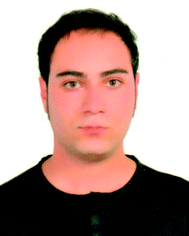
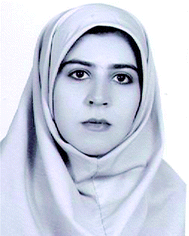
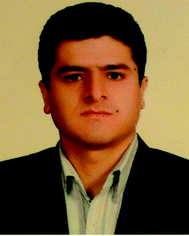

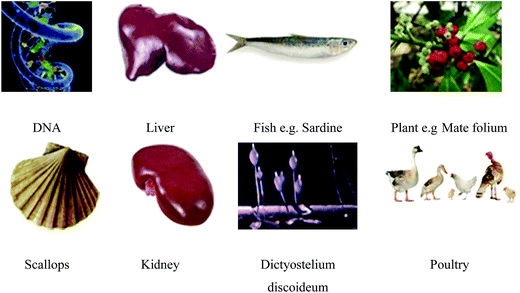
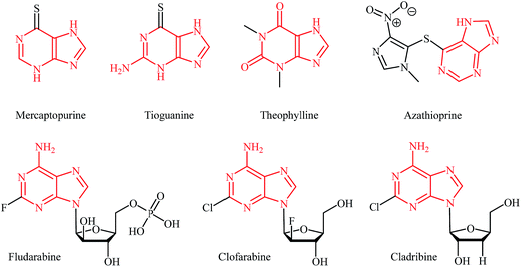


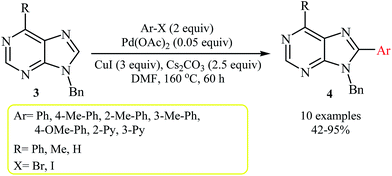
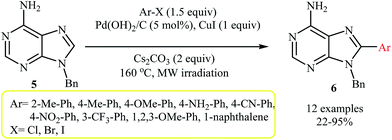
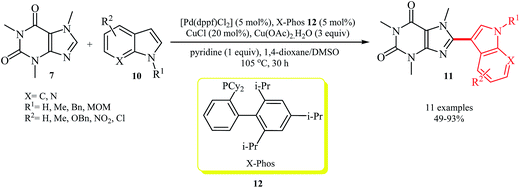
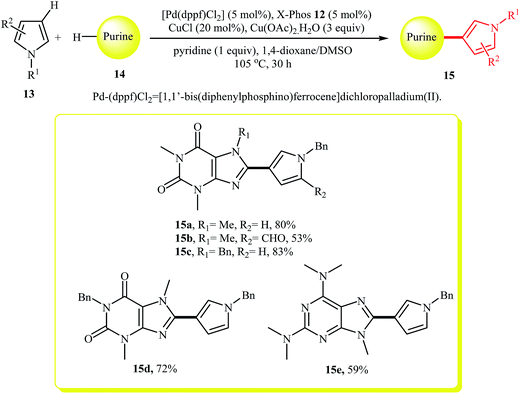
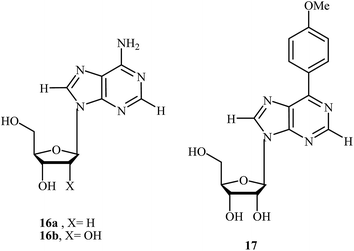
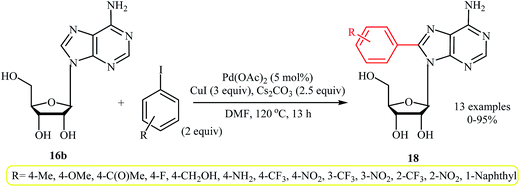
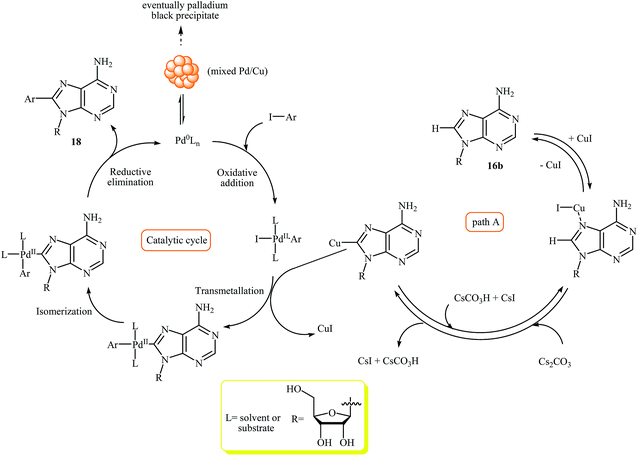
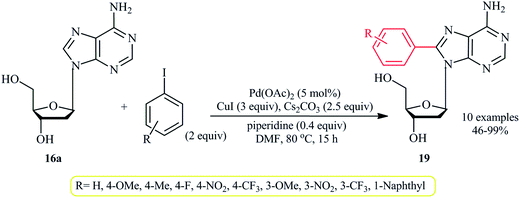


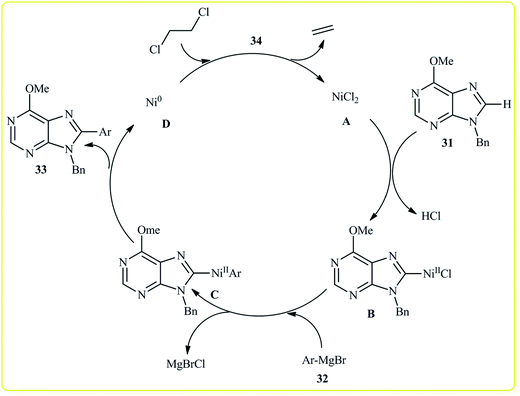
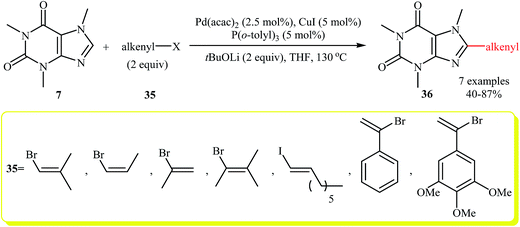

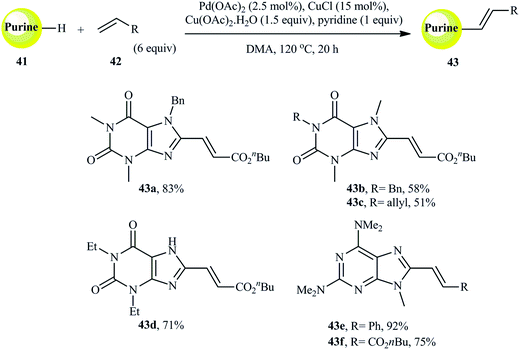




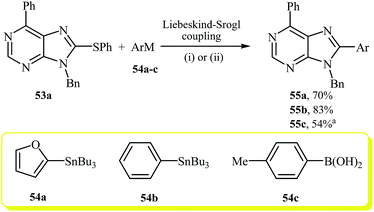
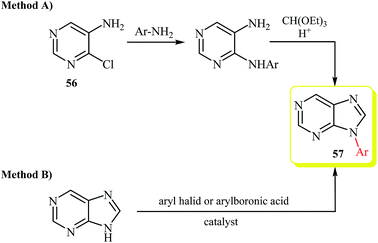
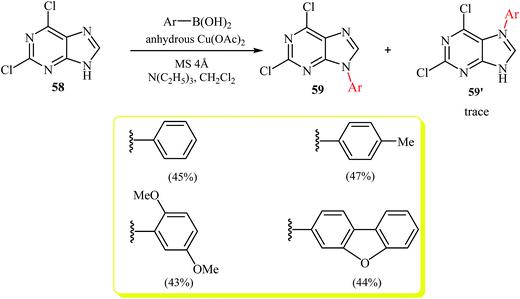

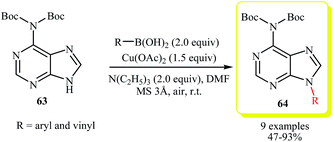

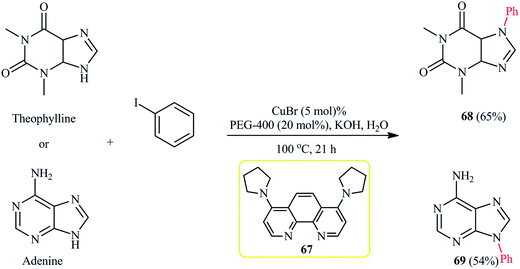

![[double bond, length as m-dash]](https://www.rsc.org/images/entities/char_e001.gif) CH
CH